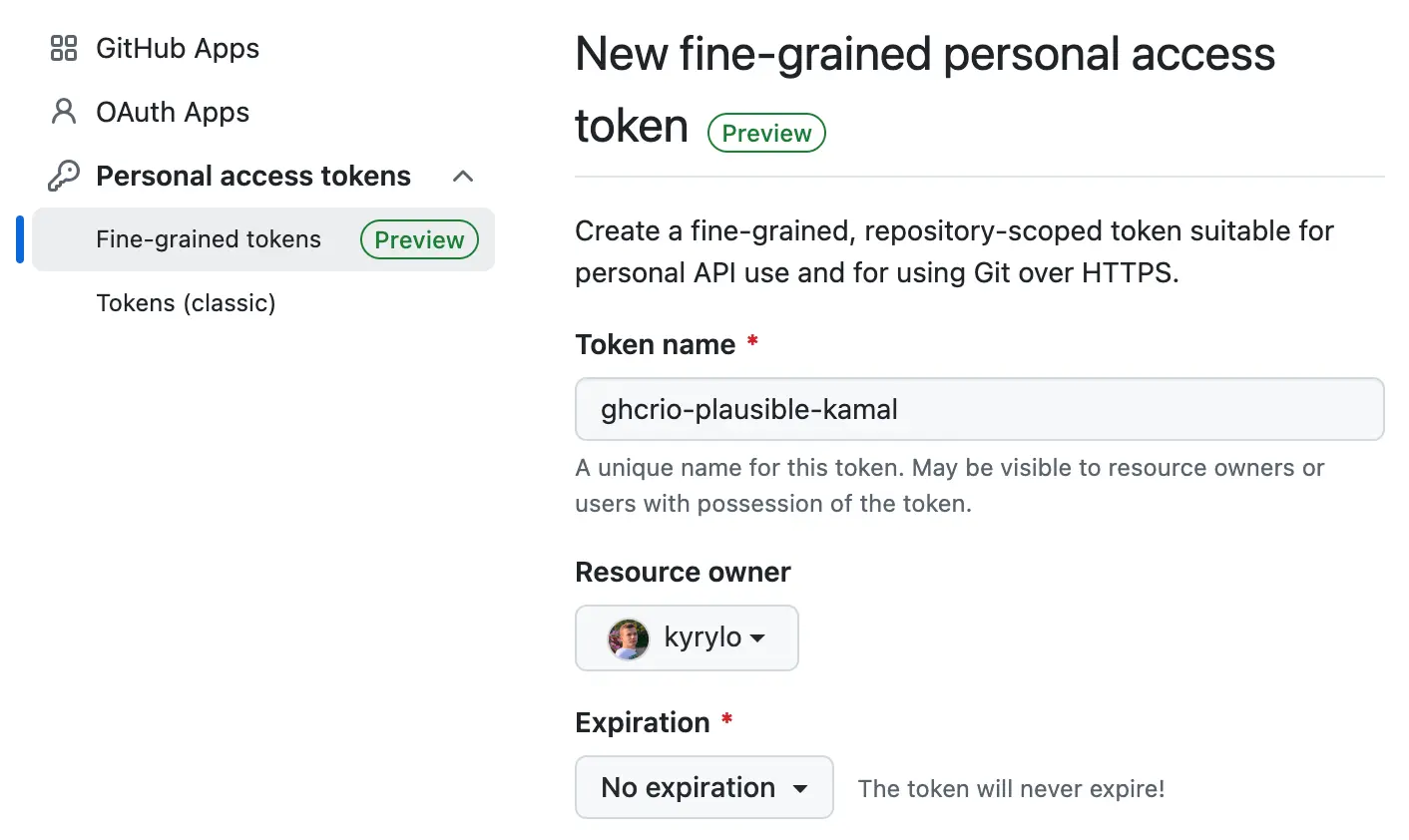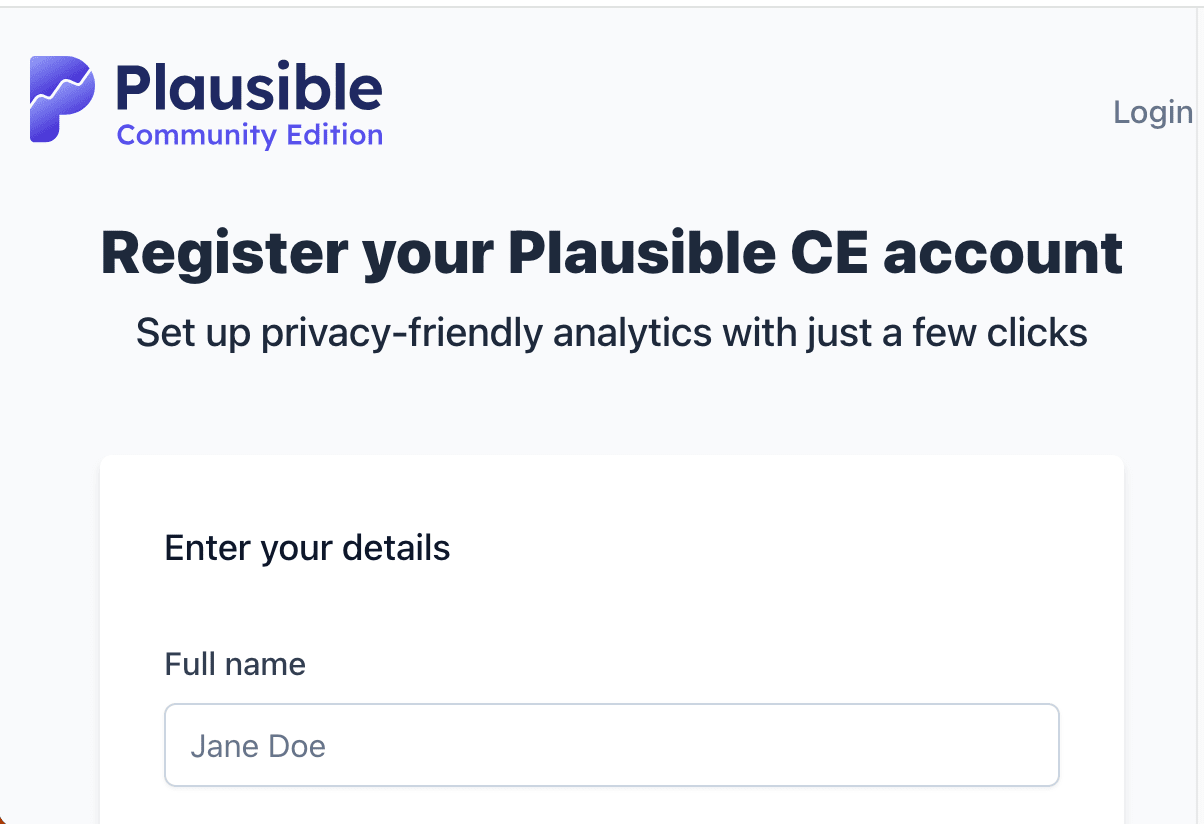In this article, I’ll guide you through the process of self-hosting Plausible Analytics with Kamal. It’s a simple, lightweight alternative to Google Analytics.
I’ve been trial-running it for a while now and really like it because it’s
straightforward and not overwhelming to use (I can now see my visitors beyond
the 30-minute mark ;-)). Since my trial period is ending soon, it was high
time to decide what to do.
You can either use Plausible in the cloud or self-host it. I chose to self-host it because Kamal makes it a breeze, and the requirements are minimal.
Requirements
Hardware
We’ll be working with the Plausible Community Edition. The hardware requirements are minimal. If you have modest needs like me, you can run it on the cheapest Hetzner Cloud instance:
Prerequisites:
- CPU must support SSE 4.2 or NEON instruction set or higher (required by ClickHouse).
- At least 2 GB of RAM is recommended for running ClickHouse and Plausible without fear of OOMs.
Subdomain
An ideal setup would involve using a subdomain for Plausible, e.g.,
plausible.example.com.
On Cloudflare, you can create an A record pointing to your server’s IP address. This will allow you to access Plausible at https://plausible.example.com.

ghcr.io token
To pull the Plausible Community Edition Docker image, you’ll need a GitHub Container Registry (ghcr.io) token.
You can create one in your GitHub account settings:

- Go to
Settings>Developer settings>Personal access tokens>Fine-grained tokens - Keep all the default settings.
- Give it a name, e.g.
ghcr-plausible-kamal. - Make it non-expiring (I prefer this, but it’s up to you).
- Hit
Generate token.
Copy the token and store it in a safe place—you’ll need it later.
Step-by-step guide
To understand what we’ll be doing, let’s examine the compose.yml file from the Plausible Community Edition repository and translate it to a Kamal configuration.
Plausible requires two dependencies (databases):
- ClickHouse
- PostgreSQL
The main web service is Plausible itself, and we’ll pull the Docker image from the GitHub Container Registry.
With that, let’s get started!
Step 1: Clone Plausible config files
Start by cloning the repository:
git clone -b v2.1.4 --single-branch https://github.com/plausible/community-edition plausible-kamal
cd plausible-kamal
The directory name we’ll use locally is plausible-kamal. I recommend either
forking the repository or creating a new one and pushing your changes there. I
chose the latter, but it’s up to you.
Step 2: Update .gitignore
The repository includes a .gitignore file that allowlists files. We need to
update it to commit the Kamal configuration files:
# .gitignore
!.kamal
!.kamal/secrets
!.config
!config/deploy.yml
You can safely skip committing hooks; they’re unnecessary. While we’re here, let’s also allow the Dockerfile. More on that later:
# .gitignore
!Dockerfile
Here’s the complete .gitignore:
*
!compose.yml
!clickhouse/logs.xml
!clickhouse/ipv4-only.xml
!README.md
!.gitignore
!.kamal
!.kamal/secrets
!config
!config/deploy.yml
!Dockerfile
Commit these changes so the new .gitignore rules are applied:
git add .gitignore
git commit -m "Allow Kamal configuration files + Dockerfile"
Step 3: Generate Kamal configuration
If you don’t have Kamal installed, you can install it via RubyGems:
gem install kamal
Now, generate Kamal configuration:
% kamal init
Created configuration file in config/deploy.yml
Created .kamal/secrets file
Created sample hooks in .kamal/hooks
Step 4: Create a dummy Dockerfile
Currently, Kamal doesn’t support deploying public Docker images directly. As a workaround, we’ll create a dummy Dockerfile that “wraps” the Plausible Docker image:
% echo "FROM ghcr.io/plausible/community-edition:v2.1.4" > Dockerfile
Step 5: Log into GitHub Container Registry
This is where the GitHub Container Registry token comes in. For my Kamal registry, I use Docker Hub, but Plausible is hosted on GitHub Container Registry, so we need to log in manually:
echo <github_token> | docker login ghcr.io -u kyrylo --password-stdin
Step 6: Setting up Kamal secrets
Plausible requires several mandatory environment variables:
SECRET_KEY_BASE:Configures the secret used for sessions in the dashboard and for generating other secrets like TOTP Vault Key.
BASE_URL:Configures the base URL to use in link generation and Cross-Site WebSocket Hijacking (CSWSH) checks.
We also need database passwords:
POSTGRES_PASSWORD: For PostgreSQL.CLICKHOUSE_PASSWORD: For ClickHouse.
Finally, don’t forget to set the KAMAL_REGISTRY_PASSWORD. If you’re using
GitHub Container Registry, set it to the GitHub token we used earlier.
Otherwise, use your Docker Hub password or token.
Here’s how your config/secrets should look like:
# config/secrets
KAMAL_REGISTRY_PASSWORD=$KAMAL_REGISTRY_PASSWORD
SECRET_KEY_BASE=$SECRET_KEY_BASE
POSTGRES_PASSWORD=$POSTGRES_PASSWORD
CLICKHOUSE_PASSWORD=$CLICKHOUSE_PASSWORD
For brevity, I’ll populate these secrets with values from the environment—it’s the easiest way. There are more options available in Kamal’s documentation.
# Somewhere in your shell configuration
export KAMAL_REGISTRY_PASSWORD=<your Docker registry password/token>
export SECRET_KEY_BASE=$(openssl rand -base64 48)
export POSTGRES_PASSWORD=postgres
export CLICKHOUSE_PASSWORD=
SECRET_KEY_BASE is generated randomly. Make sure not to lose it after it’s
generated and used!
CLICKHOUSE_PASSWORD can be left empty; it’s not mandatory to set it.
POSTGRES_PASSWORD can be set to anything you like; I set it to postgres.
We’re done with the secrets! Now, we just need to set some environment variables in the Kamal configuration.
Step 7: Update Kamal configuration
We’re almost there! Let’s update the Kamal configuration file. I’ll walk you through the key sections and, at the end, provide the full configuration so you can easily copy-paste it and adjust it to your needs.
First, let’s set the service name and image. We’ll use the custom image we created in Step 4.
service: plausible
image: <your name>/plausible
Next, we need to define the servers. We’ll have just one server, named web,
and specify the command to run, copied directly from compose.yml:
servers:
web:
hosts:
- <your-server-ip>
cmd: sh -c "/entrypoint.sh db createdb && /entrypoint.sh db migrate && /entrypoint.sh run"
Now, let’s configure the kamal-proxy
settings to enable SSL for our Plausible instance. We’ll use the subdomain
created earlier. Important: Plausible runs on port 8000, but kamal-proxy
expects the app to run on port 3000 by default. So, we need to set the correct
port:
proxy:
ssl: true
host: plausible.example.com
app_port: 8000
Next, we’ll define the environment variables for the web service. We’ll set
BASE_URL, DATABASE_URL, and CLICKHOUSE_DATABASE_URL as clear variables, while
SECRET_KEY_BASE will be pulled from the secrets file.
The DATABASE_URL and CLICKHOUSE_DATABASE_URL connection strings point to
hosts that Docker will resolve. The hostnames plausible-db and
plausible-events-db are derived from the service name (plausible) and the
accessory name (db or events-db). For example, plausible-db will be used
as the host for PostgreSQL.
Let’s set the environment variables:
env:
clear:
BASE_URL: https://plausible.example.com
DATABASE_URL: postgres://postgres:postgres@plausible-db:5432/plausible_db
CLICKHOUSE_DATABASE_URL: http://plausible-events-db:8123/plausible_events_db
secret:
- SECRET_KEY_BASE
Now, let’s define the accessories. We need two: db and events-db.
The db accessory is a PostgreSQL database. Pay attention to the port
declaration. Instead of port: 5432, we use port: 127.0.0.1:5432:5432 to
ensure the database isn’t exposed to the outside world.
accessories:
db:
image: postgres:16-alpine
host: <your-ip>
port: "127.0.0.1:5432:5432"
env:
secret:
- POSTGRES_PASSWORD
directories:
- db-data:/var/lib/postgresql/data
The events-db accessory is a ClickHouse database. We follow the same pattern
as with PostgreSQL. Additionally, we copy configuration files to the ClickHouse
container from the Plausible Community Edition repository.
events-db:
image: clickhouse/clickhouse-server:24.3.3.102-alpine
host: <your-ip>
port: "127.0.0.1:8123:8123"
env:
secret:
- CLICKHOUSE_PASSWORD
directories:
- event-data:/var/lib/clickhouse
- event-logs:/var/log/clickhouse-server
files:
- ./clickhouse/logs.xml:/etc/clickhouse-server/config.d/logs.xml:ro
# This makes ClickHouse bind to IPv4 only, since Docker doesn't enable IPv6 in bridge networks by default.
# Fixes "Listen [::]:9000 failed: Address family for hostname not supported" warnings.
- ./clickhouse/ipv4-only.xml:/etc/clickhouse-server/config.d/ipv4-only.xml:ro
And we’re done! Here’s the full configuration:
# config/deploy.yml
service: plausible
image: <your name>/plausible
servers:
web:
hosts:
- <your-ip>
cmd: sh -c "/entrypoint.sh db createdb && /entrypoint.sh db migrate && /entrypoint.sh run"
proxy:
ssl: true
host: plausible.<example.com>
app_port: 8000
registry:
username: <your name>
password:
- KAMAL_REGISTRY_PASSWORD
builder:
arch: amd64
env:
clear:
BASE_URL: https://plausible.<example.com>
DATABASE_URL: postgres://postgres:postgres@plausible-db:5432/plausible_db
CLICKHOUSE_DATABASE_URL: http://plausible-events-db:8123/plausible_events_db
secret:
- SECRET_KEY_BASE
accessories:
db:
image: postgres:16-alpine
host: <your-ip>
port: "127.0.0.1:5432:5432"
env:
secret:
- POSTGRES_PASSWORD
directories:
- db-data:/var/lib/postgresql/data
events-db:
image: clickhouse/clickhouse-server:24.3.3.102-alpine
host: <your-ip>
port: "127.0.0.1:8123:8123"
env:
secret:
- CLICKHOUSE_PASSWORD
directories:
- event-data:/var/lib/clickhouse
- event-logs:/var/log/clickhouse-server
files:
- ./clickhouse/logs.xml:/etc/clickhouse-server/config.d/logs.xml:ro
# This makes ClickHouse bind to IPv4 only, since Docker doesn't enable IPv6 in bridge networks by default.
# Fixes "Listen [::]:9000 failed: Address family for hostname not supported" warnings.
- ./clickhouse/ipv4-only.xml:/etc/clickhouse-server/config.d/ipv4-only.xml:ro
To verify that the configuration is correct, run:
% kamal config
Wonderful! If everything looks good, commit your changes:
git add .
git commit -m "Add Kamal configuration"
Step 8: Deploy Plausible
I deployed Plausible on a server that had already been provisioned with Kamal.
If you’re using a fresh server, you’ll likely want to run kamal setup and be
done.
In my case, the server was already running Kamal containers, so I needed to boot my accessories first. I did this with the following command1:
% kamal accessory boot all
Then, I deployed the service:
% kamal deploy
This will take a minute or two to create the databases and tables, and it will then crash happily with the following error:
Error: target failed to become healthy
Don’t panic! I’m not sure why, but if you run kamal deploy again, it will work
as expected:
% kamal deploy
Once everything is successful, you should be able to visit
https://plausible.example.com and see the Plausible sign-up page.
Congratulations, you’ve just self-hosted Plausible Analytics with Kamal! I’m
proud of you!

-
If your Kamal version is different from the one you previously used, ensure you match it. As of writing, the latest version is
2.3.0, but my old server was provisioned with version2.2.2.To address this, specify the version inline:
kamal _2.2.2_ deploy
